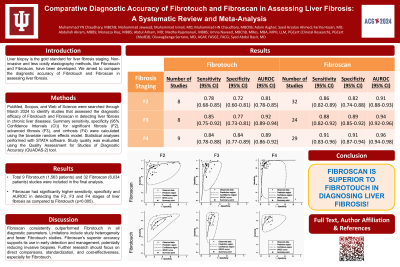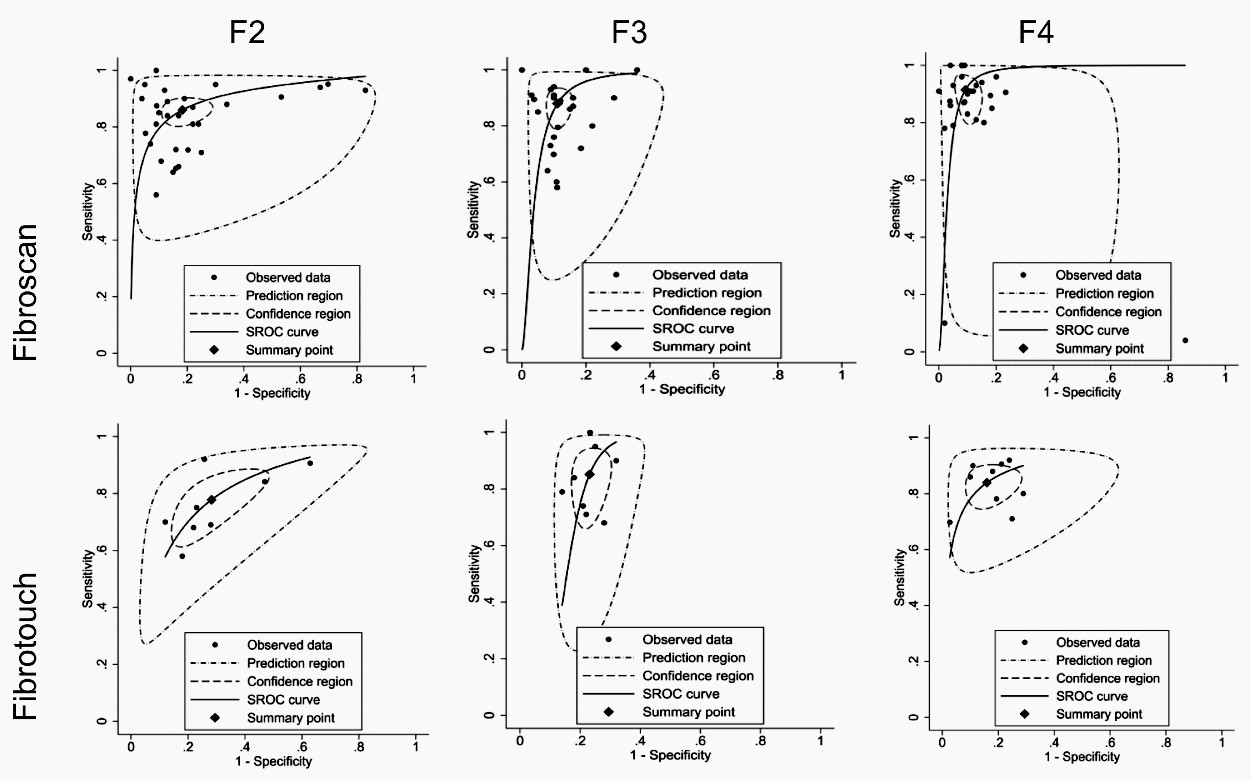Tuesday Poster Session
Category: Liver
P4671 - Comparative Diagnostic Accuracy of Fibrotouch and Fibroscan in Assessing Liver Fibrosis: A Systematic Review and Meta-Analysis
Tuesday, October 29, 2024
10:30 AM - 4:00 PM ET
Location: Exhibit Hall E

Has Audio

Muhammad YN Chaudhary, MBChB
Indiana University Southwest
Evansville, IN
Presenting Author(s)
Muhammad YN. Chaudhary, MBChB1, Mohammad Jawwad, MBBS2, Muhammad Ismail, MD3, Muhammad H N. Chaudhary, MBChB4, Adam Asghar, MBBS2, Syed Arsalan Ahmed, 2, Fariha Hasan, MD5, Abdullah Akram, MBBS2, Monazza Riaz, MBBS6, Abdul Arham, MD7, Medha Rajamanuri, MBBS8, Umna Naveed, MBChB, MBA, MPH9, Oluwagbenga Serrano, MD, FACG10, Syed Abdul Basit, MD11
1Indiana University Southwest, Evansville, IN; 2Dow Medical College, Karachi, Sindh, Pakistan; 3Indiana University Southwest, Cedar Rapids, IA; 4Manchester University NHS Foundation Trust, Stockport, England, United Kingdom; 5Cooper University Hospital, Philadelphia, PA; 6Dow Medical College, Norwich, England, United Kingdom; 7Baystate Medical Center, Chicopee, MA; 8Southern Illinois University, Springfield, IL; 9NHS, Liverpool, England, United Kingdom; 10Good Samaritan Hospital, Vincennes, IN; 11Southern Hills Medical Center, Las Vegas, NV
Introduction: Liver biopsy is the gold standard for liver fibrosis staging, which is crucial for managing chronic liver diseases (CLDs). Since it is invasive and costly, alternative non-invasive elastography methods have been developed including Fibroscan, and more recently, Fibrotouch. This meta-analysis compares the diagnostic accuracy of Fibrotouch and Fibroscan in CLDs, providing insights into their performance and clinical applications.
Methods: PubMed, Scopus, and Web of Science databases were used to review studies, up to March 2024, that assessed the diagnostic performance of Fibrotouch and Fibroscan in detecting liver fibrosis due to Hepatitis B and C, alcoholic liver disease, and non-alcoholic liver disease. Data on sensitivity and specificity for significant fibrosis (F2), advanced fibrosis (F3), and cirrhosis (F4) were extracted. We calculated summary sensitivity, specificity, area under receiver operating characteristic curve (AUROC), using the Bivatiate random effects model. Statistical analyses were performed with STATA software and The Quality Assessment for Studies of Diagnostic Accuracy (QUADAS-2) tool evaluated study quality.
Results: Included studies comprised 32 Fibroscan studies with 6,034 patients and 9 Fibrotouch studies with 1,563 patients. Using Fibrotouch and Fibroscan, the summary sensitivity for detecting F2 was 0.78 (95% CI: 0.68-0.85) vs. 0.86 (95% CI: 0.82-0.89), for F3 0.85 (95% CI: 0.75-0.92) vs. 0.88 (95% CI: 0.82-0.92), and F4 0.84 (95% CI: 0.78-0.88) vs. 0.91 (95% CI: 0.83-0.96) respectively. The summary specificity for detecting F2 was 0.72 (95% CI: 0.60-0.81) vs. 0.82 (95% CI: 0.74-0.88), for F3 0.82 (95% CI: 0.74-0.88) vs. 0.89 (95% CI: 0.85-0.92), and for F4 0.84 (95% CI: 0.77-0.89) vs. 0.91 (95% CI: 0.87-0.94) respectively. Fibroscan had significantly higher sensitivity, specificity and AUROC in detecting the F2, F3 and F4 stages of liver fibrosis as compared to Fibrotouch (p< 0.005). Figure 1 and Table 1 summarize the results.
Discussion: Fibroscan consistently outperformed Fibrotouch in diagnosing liver fibrosis (F2, F3, F4) with higher sensitivity, specificity, and AUROC values. Despite comprehensive inclusion and quality assessment, limitations include study heterogeneity and fewer Fibrotouch studies. Fibroscan's superior accuracy supports its use in early detection and management, potentially reducing invasive biopsies. Further research should focus on direct comparisons, standardization, and cost-effectiveness, especially for Fibrotouch.

Note: The table for this abstract can be viewed in the ePoster Gallery section of the ACG 2024 ePoster Site or in The American Journal of Gastroenterology's abstract supplement issue, both of which will be available starting October 27, 2024.
Disclosures:
Muhammad YN. Chaudhary, MBChB1, Mohammad Jawwad, MBBS2, Muhammad Ismail, MD3, Muhammad H N. Chaudhary, MBChB4, Adam Asghar, MBBS2, Syed Arsalan Ahmed, 2, Fariha Hasan, MD5, Abdullah Akram, MBBS2, Monazza Riaz, MBBS6, Abdul Arham, MD7, Medha Rajamanuri, MBBS8, Umna Naveed, MBChB, MBA, MPH9, Oluwagbenga Serrano, MD, FACG10, Syed Abdul Basit, MD11. P4671 - Comparative Diagnostic Accuracy of Fibrotouch and Fibroscan in Assessing Liver Fibrosis: A Systematic Review and Meta-Analysis, ACG 2024 Annual Scientific Meeting Abstracts. Philadelphia, PA: American College of Gastroenterology.
1Indiana University Southwest, Evansville, IN; 2Dow Medical College, Karachi, Sindh, Pakistan; 3Indiana University Southwest, Cedar Rapids, IA; 4Manchester University NHS Foundation Trust, Stockport, England, United Kingdom; 5Cooper University Hospital, Philadelphia, PA; 6Dow Medical College, Norwich, England, United Kingdom; 7Baystate Medical Center, Chicopee, MA; 8Southern Illinois University, Springfield, IL; 9NHS, Liverpool, England, United Kingdom; 10Good Samaritan Hospital, Vincennes, IN; 11Southern Hills Medical Center, Las Vegas, NV
Introduction: Liver biopsy is the gold standard for liver fibrosis staging, which is crucial for managing chronic liver diseases (CLDs). Since it is invasive and costly, alternative non-invasive elastography methods have been developed including Fibroscan, and more recently, Fibrotouch. This meta-analysis compares the diagnostic accuracy of Fibrotouch and Fibroscan in CLDs, providing insights into their performance and clinical applications.
Methods: PubMed, Scopus, and Web of Science databases were used to review studies, up to March 2024, that assessed the diagnostic performance of Fibrotouch and Fibroscan in detecting liver fibrosis due to Hepatitis B and C, alcoholic liver disease, and non-alcoholic liver disease. Data on sensitivity and specificity for significant fibrosis (F2), advanced fibrosis (F3), and cirrhosis (F4) were extracted. We calculated summary sensitivity, specificity, area under receiver operating characteristic curve (AUROC), using the Bivatiate random effects model. Statistical analyses were performed with STATA software and The Quality Assessment for Studies of Diagnostic Accuracy (QUADAS-2) tool evaluated study quality.
Results: Included studies comprised 32 Fibroscan studies with 6,034 patients and 9 Fibrotouch studies with 1,563 patients. Using Fibrotouch and Fibroscan, the summary sensitivity for detecting F2 was 0.78 (95% CI: 0.68-0.85) vs. 0.86 (95% CI: 0.82-0.89), for F3 0.85 (95% CI: 0.75-0.92) vs. 0.88 (95% CI: 0.82-0.92), and F4 0.84 (95% CI: 0.78-0.88) vs. 0.91 (95% CI: 0.83-0.96) respectively. The summary specificity for detecting F2 was 0.72 (95% CI: 0.60-0.81) vs. 0.82 (95% CI: 0.74-0.88), for F3 0.82 (95% CI: 0.74-0.88) vs. 0.89 (95% CI: 0.85-0.92), and for F4 0.84 (95% CI: 0.77-0.89) vs. 0.91 (95% CI: 0.87-0.94) respectively. Fibroscan had significantly higher sensitivity, specificity and AUROC in detecting the F2, F3 and F4 stages of liver fibrosis as compared to Fibrotouch (p< 0.005). Figure 1 and Table 1 summarize the results.
Discussion: Fibroscan consistently outperformed Fibrotouch in diagnosing liver fibrosis (F2, F3, F4) with higher sensitivity, specificity, and AUROC values. Despite comprehensive inclusion and quality assessment, limitations include study heterogeneity and fewer Fibrotouch studies. Fibroscan's superior accuracy supports its use in early detection and management, potentially reducing invasive biopsies. Further research should focus on direct comparisons, standardization, and cost-effectiveness, especially for Fibrotouch.

Figure: Figure 1: SROC curves of Fibroscan and Fibrotouch in diagnosing all stages of liver fibrosis - significant fibrosis (F2), advanced fibrosis (F3), cirrhosis (F4).
Note: The table for this abstract can be viewed in the ePoster Gallery section of the ACG 2024 ePoster Site or in The American Journal of Gastroenterology's abstract supplement issue, both of which will be available starting October 27, 2024.
Disclosures:
Muhammad Chaudhary indicated no relevant financial relationships.
Mohammad Jawwad indicated no relevant financial relationships.
Muhammad Ismail indicated no relevant financial relationships.
Muhammad Chaudhary indicated no relevant financial relationships.
Adam Asghar indicated no relevant financial relationships.
Syed Arsalan Ahmed indicated no relevant financial relationships.
Fariha Hasan indicated no relevant financial relationships.
Abdullah Akram indicated no relevant financial relationships.
Monazza Riaz indicated no relevant financial relationships.
Abdul Arham indicated no relevant financial relationships.
Medha Rajamanuri indicated no relevant financial relationships.
Umna Naveed indicated no relevant financial relationships.
Oluwagbenga Serrano: MERCK – Stock-publicly held company(excluding mutual/index funds).
Syed Abdul Basit indicated no relevant financial relationships.
Muhammad YN. Chaudhary, MBChB1, Mohammad Jawwad, MBBS2, Muhammad Ismail, MD3, Muhammad H N. Chaudhary, MBChB4, Adam Asghar, MBBS2, Syed Arsalan Ahmed, 2, Fariha Hasan, MD5, Abdullah Akram, MBBS2, Monazza Riaz, MBBS6, Abdul Arham, MD7, Medha Rajamanuri, MBBS8, Umna Naveed, MBChB, MBA, MPH9, Oluwagbenga Serrano, MD, FACG10, Syed Abdul Basit, MD11. P4671 - Comparative Diagnostic Accuracy of Fibrotouch and Fibroscan in Assessing Liver Fibrosis: A Systematic Review and Meta-Analysis, ACG 2024 Annual Scientific Meeting Abstracts. Philadelphia, PA: American College of Gastroenterology.
